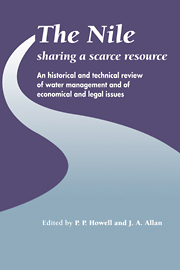 The Nile: Sharing a Scarce Resource
The Nile: Sharing a Scarce Resource Published online by Cambridge University Press: 05 February 2012
Introduction
The drought which has ravaged most Sahelian countries during the 1970 and 1980 decades is unprecedented in recent records. The objective of this chapter is to compare the recent sequence of low Nile floods with past historical evidence of droughts in Egypt; an attempt to put this century's flows in an historical context.
The major question facing engineers, planners and politicians alike is whether this drought will continue; whether this persistence of low rainfall years in the Sahel is just further evidence of the natural ‘Hurst Phenomena’, whereby sequences of low Nile flows and large Nile floods tend to occur together, or whether it is man-made, possibly a manifestation of global warming representing a permanent or semi-permanent change in the general circulation of the atmosphere influencing the continental climate of Africa.
The Sahel is a region with steep rainfall gradients with annual rainfall decreasing rapidly from 600 mm to less than 200 mm in a few hundred kilometres. Slight shifts in the circulation can cause major problems which would go unnoticed in other climatic zones.
The Nile is the birth place of hydrology. No other river provides such a wealth of information. Available records reach back to before 3000 BC. The heavy dependence of Egyptian civilisation on the size of Nile floods, leading to years of famine or plenty, and the ability of Egyptian dynastic society to record evidence for posterity provides a unique opportunity to investigate historical river flows.
To save this book to your Kindle, first ensure [email protected] is added to your Approved Personal Document E-mail List under your Personal Document Settings on the Manage Your Content and Devices page of your Amazon account. Then enter the ‘name’ part of your Kindle email address below. Find out more about saving to your Kindle.
Note you can select to save to either the @free.kindle.com or @kindle.com variations. ‘@free.kindle.com’ emails are free but can only be saved to your device when it is connected to wi-fi. ‘@kindle.com’ emails can be delivered even when you are not connected to wi-fi, but note that service fees apply.
Find out more about the Kindle Personal Document Service.
To save content items to your account, please confirm that you agree to abide by our usage policies. If this is the first time you use this feature, you will be asked to authorise Cambridge Core to connect with your account. Find out more about saving content to Dropbox.
To save content items to your account, please confirm that you agree to abide by our usage policies. If this is the first time you use this feature, you will be asked to authorise Cambridge Core to connect with your account. Find out more about saving content to Google Drive.